AOAC. 1995. Official Methods of Analysis. 16th ednAssociation of Official Analytical Chemists; Arlington, VA, USA:
Aydin I, Kucuk E, Sahin T, Kolotoglu L. 2011. The effect of feeding frequency and feeding rate on growth performance of juvenile Black Sea Turbot, Psetta maxima (Linneaus, 1758). J Fishscicom 5:35â42.
Bai SC, Okorie OE. 2009. Marine fish. Korean Rockfish (Sebastes schlegeli) Production in Korea. Global Aquaculture Advocate 41â42.
Biswas G, Jena JK, Singh SK, Patmajhi P, Muduli KK. 2006. Effect of feeding frequency on growth, survival and feed utilization in mrigal (
Cirrhinus mrigala) and rohu (
Labeo rohita) during nursery rearing. Aquaculture 254:211â218.

Biswas G, Thirunavukkarasu AR, Sundaray JK, Kailasam M. 2010. Optimization of feeding frequency of Asian seabass (
Lates calcarifer) fry reared in net cages under brackishwater environment. Aquaculture 305:26â31.

Bjornsson B, Steinarsson A, Arnason T. 2007. Growth model for Atlantic cod (Gadus morhua): Effects of temperature and body weight on growth rate. Aquaculture 271216â226.
Booth MA, Tucker BJ, Allan GL, Fielder D. 2008. Effect of feeding regime and fish size on weight gain, feed intake and gastric evacuation in juvenile Australian snapper (
Pagrus auratus). Aquaculture 282:104â110.

Brown BA. 1980. Routine hematology procedures. Hematology: Principles and Procedures. Lea , Febiger , editorsLea and Febiger Co; Philadelphia, USA: p. 71â112.
Cho SH, Lim YS, Lee JH, Park S, Lee SM. 2003. Effect of feeding rate and feeding frequency on survival, growth, and body composition of Ayu post-larvae Plecoglossus altivelis. J World Aquac Soc 34:85â91.

Cho SH, Lee SM, Park BH, Ji SC, Choi CY, Lee JH, Kim YC, Lee JH, Oh SY. 2007. Effect of daily feeding ratio on growth and body composition of subadult olive flounder, Paralichthys olivaceus, fed an extruded diet during the summer season. J World Aquac Soc 38:68â73.

Cho SH. 2012. Effects of dietary nutrient on the biological index and serum chemistry of juvenile Olive flounder Paralichthys olivaceous achieving compensatory growth. Fish Aquat Sci 15:69â72.
Dwyer KS, Brown JA, Parrish C, Lall SP. 2002. Feeding frequency affects food consumption, feeding pattern and growth of juvenile yellowtail flounder (
Limanda ferruginea). Aquaculture 213:279â292.

Folkvord A, Ottera H. 1993. Effects of initial size distribution, day length, and feeding frequency on growth, survival and cannibalism in juvenile Atlantic cod (
Gadus morhua). Aquaculture 114:243â260.

Gardeur JN, Mathis N, Kobilinsky A, Brun-Bellut J. 2007. Simultaneous effects of nutritional and environmental factors on growth and flesh quality of Perca fluviatilis using a fractional factorial design study. Aquaculture 273:50â63.

Hutson AM, Toya LA, Tave D. 2013. Effect of High Stocking Rates on Growth and Survival of the Endangered Rio Grande Silvery Minnow Hybognathus marus. Fish Aquat. Sci 16:285â290.
Kayano Y, Yao S, Yamamoto S, Nakagawa H. 1993. Effects of feeding frequency on the growth and body constituents of young red-spotted grouper,
Epinephelus akaara. Aquaculture 110:271â278.

Kim KD, Kang YJ, Kim KW, Kim KM. 2007. Effects of feeding rate on growth and body composition of juvenile flounder. J World Aquac Soc 38:169â173.

Lee SM, Hwang UG, Cho SH. 2000. Effects of feeding frequency and dietary moisture content on growth, body composition and gastric evacuation of juvenile Korean rockfish (
Sebastes schlegeli). Aquaculture 187:399â409.

Lee SM, Pham MA. 2010. Effects of feeding frequency and feed type on the growth, feed utilization and body composition of juvenile olive flounder (
Paralichthys olivaceus). Aquac. Res 41:e166âe171.

Mizanur RM, Bai SC. 2014. A review of the optimum feeding rates and feeding frequency in Korean rockfish (
Sebastes schlegeli) reared at seven different water temperatures. Fish Aquat Sci 17:1â19.

Mizanur RM, Park G, Yun HH, Lee S, Choi S, Bai SC. 2014a. The effects of feeding rates in juvenile Korean rockfish (
Sebastes schlegeli) reared at 17°C and 20°C water temperatures. Aquacult Int 22:1121â1130.

Mizanur RM, Yun HH, Moniruzzaman M, Ferreira F, Kim KW, Bai SC. 2014b. Effects of feeding rate and water temperature on growth and body composition of Juvenile Korean Rockfish,
Sebastes schlegeli (Hilgendorf 1880). Asian Australas J Anim Sci 27:690â699.



Moore RK, Scott AP, Collins PM. 2000. Circulating C-21 steroids in relation to reproductive condition of a viviparous marine teleost,
Sebastes rastrelliger(grass rockfish). Gen Comp Endocrinol 117:268â280.


NRC. 2011. Nutrient Requirements of Fish and Shrimp. National Academies Press; NY, USA:
Oh SY, Noh CH, Kang RS, Kim CK, Cho SH, Jo JY. 2008. Compensatory growth and body composition of juvenile black rockfish
Sebastes schlegeli following feed deprivation. Fish Sci 74:846â852.

Okorie OE, Bae JY, Kim KW, Son MH, Kim JW, Bai SC. 2013. Optimum feeding rates in juvenile olive flounder,
Paralichthys olivaceu s, at the optimum rearing temperature. Aquac Nutr 19:267â277.

Park IS, Kim CH, Choi JW. 2012. Histological observations and regeneration of barbles in juveniles of the Chinese Longsnout catfish Leiocassis longirostris. Fish Aquat Sci 15:299â303.
Person-Le RJ, Buchet V, Vincent B, Le DH, Quemener L. 2006. Effects of temperature on the growth of pollack (
Pollachius pollachius) juveniles. Aquaculture 251:340â345.

Qiao G, Park SI, Xu DH. 2012. Clinical, hematological and biochemical alterations in Olive flounder
Paralichthys olivaceus following experimental infection by
Vibrio scophthalmi. Fish Aquat Sci 15:233â239.

Schnaittacher G, King WV, Berlins DL. 2005. The effects of feeding frequency on growth of juvenile Atlantic halibut (
Hippoglossus hippoglossus). Aquac Res 36:370â377.

Silva CR, Gomes LC, Brandao FR. 2007. Effect of feeding rate and frequency on tambaqui (
Colossoma macropomum) growth, production and feeding costs during the first growth phase in cages. Aquaculture 264:135â139.

Seo JY, Lee S-M. 2008. Effects of dietary macronutrient level and feeding frequency on growth and body composition of juvenile rockfish (
Sebastes schlegeli). Aquacult Int 16:551â560.

Tucker BJ, Booth MA, Allan GL, Booth D, Fielder DS. 2006. Effects of photoperiod and feeding frequency on performance of newly weaned Australian snapper,
Pagrus auratus. Aquaculture 258:514â520.

Van Ham EH, Berntssen MHG, Imsland AK, Parpoura AC, Wenderlaar BSE, Stefansson SO. 2003. The influence of temperature and ration on growth, feed conversion, body composition and nutrition retention of juvenile turbot (
Scohthalmus maximus). Aquaculture 217:547â558.

Wang N, Xu X, Kestemont P. 2009. Effect of temperature and feeding frequency on growth performances, feed efficiency and body composition of pikeperch juveniles (
Sander lucioperca). Aquaculture 289:70â73.

Xia J, Li X. 2010. Effect of temperature on blood parameters of the salamander Batrachupems tibetanus (Schmidt, 1925) (Amphibia: Hynobiidae). Russian J Ecol 41:102â106.

Xie F, Ai Q, Mai K, Xu W, Ma H. 2011. The optimal feeding frequency of large yellow croaker (
Pseudosciaena crocea, Richardson) larvae. Aquaculture 311:162â167.



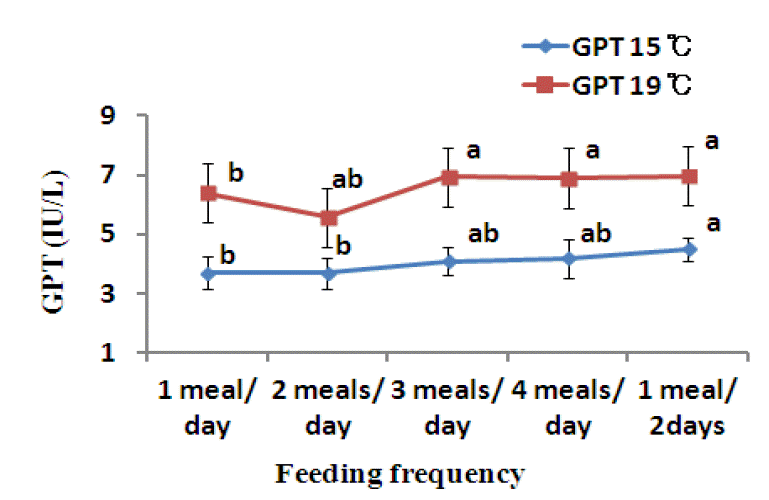
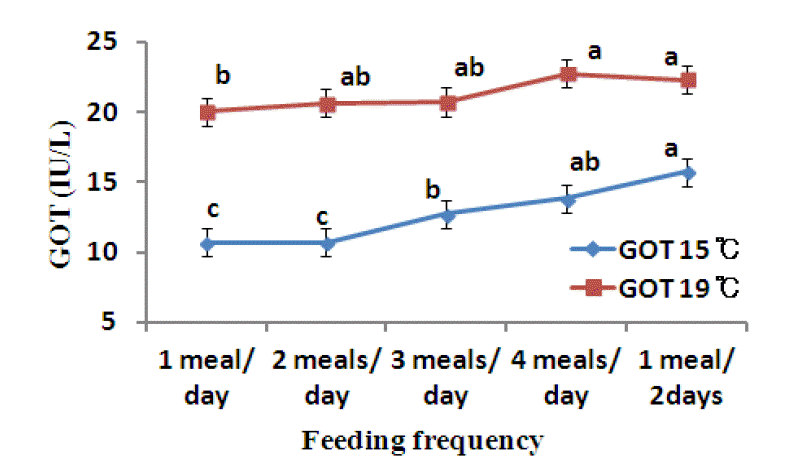
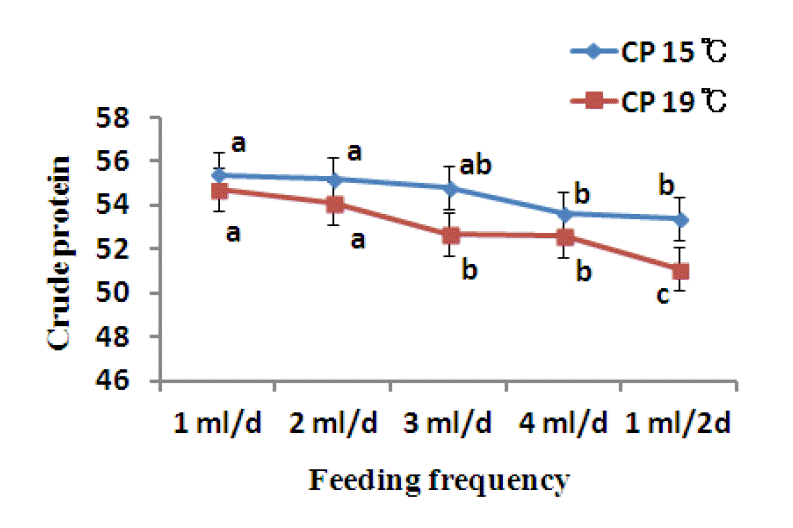





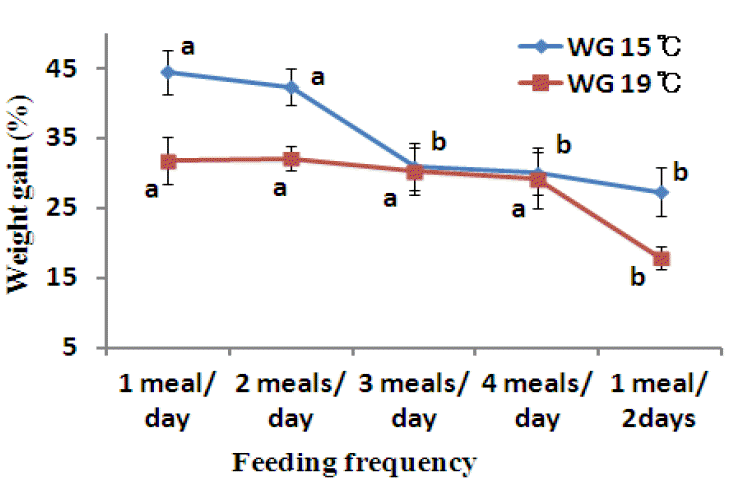
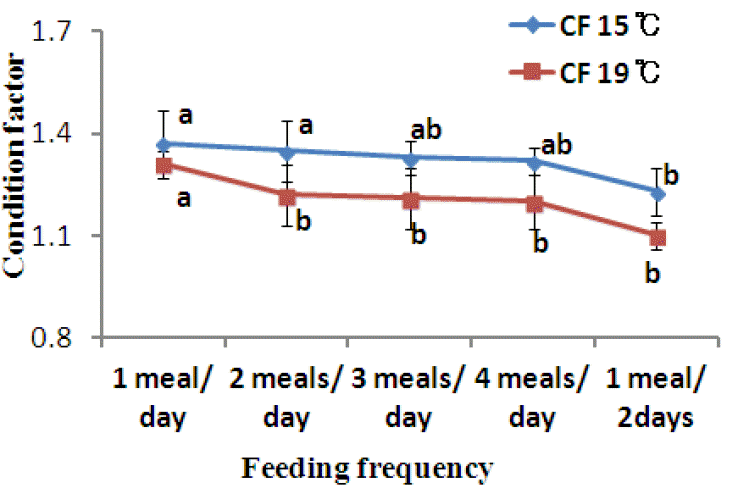
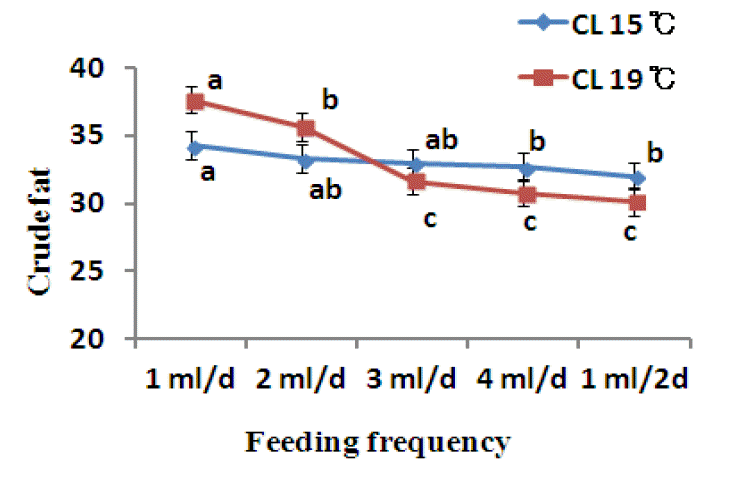
 PDF Links
PDF Links PubReader
PubReader ePub Link
ePub Link Full text via DOI
Full text via DOI Full text via PMC
Full text via PMC Download Citation
Download Citation Print
Print





